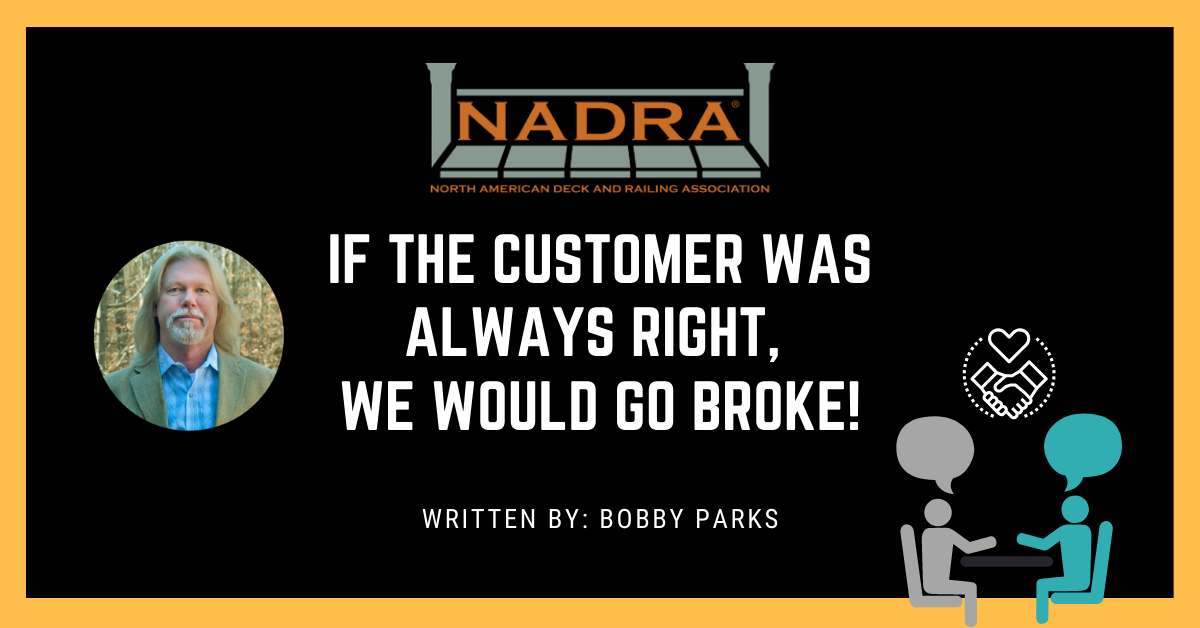By: Bobby Parks
“The customer’s always right”. It’s a common saying that some may believe, but fortunately it’s not true or we would all go broke. We would throw in the towel whenever a customer claimed something was wrong, make fixes that had nothing to do with us for free, or give them at no cost what they mistakenly thought they were supposed to receive. And we would be firing our people once a month because the customer claimed they did something wrong. Imagine the cost drain that would occur. Restaurant and retail store managers may be able to give away meals and smaller items to make a customer happy and go away, but because our servings are more costly, we as contractors can’t afford to do the same. The trick is how you explain to them why they are not right without offending or losing them in the process.
It’s not to say we as contractors don’t make mistakes or create issues for ourselves, we do. But often when issues arise or potential confrontations exist it’s because of a customer’s mistaken perception involving the scope of work, project options, or installation procedures. In rare cases, it’s a customer trying to get something for free. They see an opening and push the boundary to see if you will cave and donate to their project.
To be more specific, these undesirable communications occur when customers believe they are supposed to be getting something different than what they are getting or they believe something that is not included should be included. Often, it can include an existing condition or repair they believe should be part of the job. For example; they contracted for a deck and they believe the rot discovered after the job started at the attachment and around the fireplace bump out should be included. Or it can be technical aspects about an installation. They’ve read something or someone told them something that makes them believe you are going about it incorrectly. In any case, how you respond matters.
Communication and Documentation
Most job confusion issues result from a lack of communication, documentation, and improperly set expectations. We all know there are plenty of legitimate issues that pop up; so why allow avoidable or mistakenly perceived problems to enter the mix? When issues do occur, the objective should be to obtain a quick satisfactory resolution for all parties without relationship damage and keep the project moving forward. And without sacrificing profit!
Minimizing the potential for such adventures to occur should be a standard practice. Setting realistic expectations when contracting is much easier than setting them after the fact or while you are on the job. Writing up a contract agreement with a description of all relevant details as well as general operational clauses as to what a customer should expect and what you are responsible or not responsible for is a simple basic business practice. Typically, I had 21 standard clauses in my contract before specifics were added. These standard clauses covered everything from delays due to weather, existing rot, unforeseen conditions, lawn damage responsibility, that material left over belonged to me, measurements are approximate, and even “rights to take and use pictures”. The list goes on and there’s a reason for every clause.
There’s A Lot Discussed & Less Included
Although lots of options and details are discussed during the consultation and designing phase, specific details and final elements that are included and agreed on must be documented as later it all runs together for most customers. So, in addition to the standard clauses of a contract, numerous specific details such as rail types, decking choices, and any pertinent choices are documented. For me, a design drawing that also included some details was signed off on. Honest mistakes in memory occur with both parties, so having details benefits everyone and this alleviates or resolves a high percentage of issues when referred to. It should be comprehensive enough that a third party should be able to review a job file and know what’s being done. I also made it a point to include and attach photo examples of certain items and details to the package like rail types and trim finishes which I could refer to as well. I did this because customers don’t understand our assigned product titles or lingo, so this provided a visual that was an addendum to the contract and often used as examples when requesting HOA approvals.
From a technical and product standpoint most customers do their due diligence online. This should be expected and is good in that they can become somewhat educated regarding their investment. But it’s not good if they get bad information or interpret something that doesn’t apply to what you are doing. Chances are, the better the contractor is from a written detail and communication standpoint, the less likely these issues will come up and the more likely the customer is mistaken if it does. Now, the lesser prepared contractors will likely experience not only more issues, but the ones that come up will be trickier to resolve.
Customer confidence in who they choose as a contractor alleviates some potential issues as they trust you. If something does come up, my experience has been that they are more likely to believe you and assume they are mistaken. This comes from established credibility as a contractor and the relationship you have built with the customer. This only carries you so far. I have learned that no matter what you do and how much you cover up front, problems can arise. On occasion we or our people do stumble, which compromises us and that is challenging to recover from. Acknowledging the obvious if you are wrong is the best way to begin to recover confidence and get the relationship back on track; but if you’re in the right…then standing your ground in a professional, confident, cordial, and unemotional way is how I’d handle it.
Managing the Conversation
So, for me these conversations always included an acknowledgement that I understand they believe something was included that they are not getting, or our technical approach is not what they expected. Often the first part was resolved by referring to the detailed notes or photos we all signed off on or what was on the drawings.
If a technical issue or question came up, I’d explain why we do what we do, why we can stand behind our building methods and why we might not if we did it another way. I did not let them engineer or dictate how I was going to structure a job or approach it from a technical standpoint as my warranty only applied if it was built to my own and code standards. This assumes you have solid ground to stand on and you have not compromised yourself from a technical standpoint. Know what is required from both a code and the manufacturers aspect. For example: Customers find lots of information online with common searches involving pressure treated wood use, including, treating end cuts and stringers, or what voids a manufacturer’s warranty etc. Surprisingly, many contractors do not have a proper understanding of what is required with this aspect which can come back on them. To be caught on the wrong side of obvious technical mistakes are not only embarrassing, but really does compromise you with a customer from a confidence standpoint. You should know that everything is just a “Google” search away for the customer.
There’s a Cost Either Way
Again, you can’t give away things just to make people happy, but for me if there was a gray area with minimal cost items or a slight repair that they thought was included and I believed they genuinely believed it, I looked at it like this. Sometimes there can be a bigger long-term cost if you do collect versus absorbing the hit. So, there can be a cost to you either way even if you collect money from a customer for a disputed item. The key is to determine which is the costliest. For example, you could stand your ground and charge a customer $300-$400 for something they disagreed was owed but would reluctantly agree to pay for. How will that $300-400 compare to the cost of having an unhappy customer you’re creating in the process? How will the rest of the job go now that they have an attitude? What kind of review will you receive? How many referrals will you receive from this customer? In the long run which choice cost you the most?
But let’s say it was a $1000, or some larger dollar value. I might take the pre-mentioned approach, but instead of absorbing the full amount I might offer to discount the work or split the cost with them. I would stress again that it wasn’t part of the job, but I realize they believe it was. Just to show an effort of good faith I would make the offer. But I would not give away the $1000. My experience has been that it’s the things you give away or give a deal on that are often the problem items on a job, so I don’t take these offers lightly. Also, I know that every percentage point matters, and small amounts multiplied add up over time so what you agree to from a dollar figure depends on the size of a job and what the percentages are. For example, you wouldn’t give up $300 on a $3000 job as that would be 10% of the project. But on a $30,000 project it would only be 1% and might be something you could live with.
Reasonable People and Reasonable Solutions
I’m a believer that reasonable people listen to reason and make decisions and reach conclusions based on reason, logic, and the practicalities involved. But I believe unreasonable people or the ones that are working you for something free are not fair minded and will not reach the same decision or conclusions. That’s where firmness, backbone, and written specific details and inclusion as well as exclusion cards must be played. Standing your ground in a professional and unemotional way at this point is just part of being a business owner and required for long term survival. Some customers are more difficult than others and how to deal with difficult and unreasonable customers is an article all to itself.
But my experience has been that if I listened to the customer first and then discussed a situation professionally with a reasonable and genuine effort and attitude to resolve it, my customer relationship was strengthened. For example If I made the decision to go ahead and do a minimal cost item even though technically I could get out of it and charge, but I knew the customer truly believed they were in the right, I’d do it in a way that had value. It might be “Look I’m sorry there has been a misunderstanding and I can understand you think this was included. It honestly is not but I want you to be happy and for this not to be a problem-we are going to handle it”. And I said it in a positive way. I didn’t say it with an attitude or in a reluctant resentful way. If you did the latter, you might as well have charged them as there is no gain. I believe these customers often look back and remember that you did something that they often come to realize wasn’t part of the scope, but you did it anyway and you were nice about it.
Resolving Issues Properly Can Strengthen the Relationship
Ethical contractors strive to be fair and to satisfy their customers. Most customers are reasonable minded people just wanting us to meet their expectations that hopefully we as contractors have properly set. So, we must be fair to them but also to ourselves and to protect our businesses and livelihood and maintain a balance between the two. When practical and reasonable approaches discussed here are made and agreed upon, result in a cordial resolution; I believe these customers often give you the best reviews compared to the ones that had an uneventful experience. They have a more in-depth belief in you because the fairness and integrity test were passed versus a non-eventful delivery. Therefore, my experience has been that the contractor /customer relationship can become even stronger when an issue arises compared to a project that runs smoothly. I’m not saying you want more eventful jobs, only that if you take all the upfront precautions to cover yourself and it still happens, handle it in a manner that at the end of the day more than overcomes the few dollars you may have given on that job. Consider it an investment on your reputation and brand that creates fans of your company and may produce even stronger referrals compared to your typical jobs. And consider it a lesson learned and in some cases, an added clause to your next contract.
Bobby Parks / Instagram: @Bobbyparks007B



